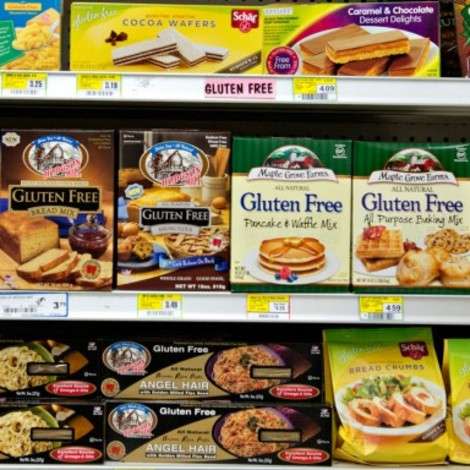Why You Shouldn't Join the Gluten-Free Craze
by Deb Dellapena for SHAPE.com

From specialized food aisles at supermarkets to separate menus at restaurants, the gluten-free craze is everywhere. And don't expect it to go away anytime soon-market research firm Mintel predicts the $10.5 billion dollar industry will skyrocket 48 percent to $15.6 billion in sales by 2016.
Great for the 1 in 133 Americans who have celiac disease and the additional 18 million who have non-celiac gluten sensitivity (NCGS), a gluten intolerance. Both must avoid gluten-the protein found in grains such as wheat, barley, triticale, and rye-or suffer bloating, gas, abdominal pain, constipation, diarrhea, and other stomach woes.
But for the other 93 percent of the population, "there really is no reason to eliminate gluten from your diet," says Laura Moore, R.D., director of the dietetic internship program at the University of Texas School of Public Health in El Paso. In fact, if you're like three-quarters of this group that Mintel reports eats gluten-free foods because they think they are healthier, cutting out gluten could mean you're cutting out these key nutrients that keep your health, energy, and metabolism at their best.
RELATED: 10 Snacking Mistakes That Cause Weight Gain
1. B Vitamins: This team of nutrients works together to convert food into energy. Too few Bs can make you feel anything from fatigue and irritability to muscle weakness and depression.
Gluten-free sources: GF oats, brown rice, quinoa, and buckwheat, as well as leafy green vegetables, legumes, seeds, chicken, beef, milk products, and pork.
Get your daily dose: Covering all your B needs (other than folate) could be accomplished by eating 1 scrambled egg, 1 cup 2-percent milk, 1 ounce raw pistachios, 1/2 cup chopped chicken breast, 1 ounce dried sunflower seeds, 3 ounces roast pork tenderloin, and 1/2 cup each sliced cooked zucchini and cooked spinach. However, if you are a gluten-free vegan, you will likely need a B12 supplement since that vitamin is only found in animal sources.
2. Iron: An essential mineral, iron delivers oxygen to red blood cells and is necessary for cellular metabolism. When you don't get enough, it can sap your energy, and you could develop anemia, which also drains your immune system, makes you feel cold, and can impair your work performance. As with B12, as long as you're eating animal products, it's not hard to meet your iron needs, says Nina Eng, R.D., chief clinical dietitian at Plainview Hospital in New York.
Gluten-free sources: Meat, seafood, legumes, spinach, GF oats, quinoa, and buckwheat. Pair iron-rich foods with those packing vitamin C such as bell peppers, citrus, broccoli, and tomatoes to enhance absorption of the mineral.
Get your daily dose: To get your iron without resorting to fortified foods, you'd need to eat 1 scrambled egg, 3 ounces canned water-packed light tuna fish (drained), 1 cup cooked shelled edamame, 6 ounces lean beef sirloin, and 1/2 cup each cooked gluten-free oats, lentils, and spinach.
3. Folate: Part of the B-vitamin family, folate is often discussed separately due to its role in preventing birth defects, Eng says. Even if you're not in baby-making mode, your cells need folate to grow and function, plus it helps keep your heart healthy.
Gluten-free sources: Beef liver, leafy greens, black-eyed peas, asparagus, and avocado.
Get your daily dose: You could eat 1 navel orange, 1/4 cup sliced avocado, 1 cup shredded romaine, 3/4 cup cooked quinoa, 1/2 cup kidney beans, and 4 cooked asparagus spears to meet your needs.
4. Fiber: In addition to filling you up and keeping you regular, fiber is associated with a lower risk of heart disease.
Gluten-free sources: Legumes, air-popped popcorn, berries, nuts and seeds, artichokes, pears, and other fruit and vegetables.
Get your daily dose: Hit your fiber target by consuming 1 medium apple, 3 cups air-popped popcorn, 1 cup each blackberries and raw spinach, and 1/2 cup each cooked lentils and Brussels sprouts.
RELATED: No More Excuses! Top 10 Tips to Stick to Your Diet
5. Satiety: Twenty-seven percent of consumers eat gluten-free products because they think doing so will help them lose weight, but this often backfires, says Jaclyn London, R.D., senior clinical dietician at Mount Sinai Medical Center in New York City. "A majority of gluten-free products are made with very low-fiber potato or flour, and they can be low in protein, making them less satisfying."
And if, as a result, you eat more, watch out: "Gluten free" is not synonymous with "low calorie." Depending on the brand and product, labels read about the same, if not worse, on gluten-free foods. For example, one brand of gluten-free chocolate chip cookies comes in at 70 calories per cookie, whereas a top regular brand registers 55 calories a pop. And chances are your mouth doesn't know that two gluten-free cookies is the same serving size as three non-gluten-free ones, and you'll eat both to your stomach's content.
MORE ON SHAPE:
The New Science Behind Working Out
20 Sweet and Salty Snacks Under 200 Cals
5 Surprising Ways Stress Messes With Your Workout
